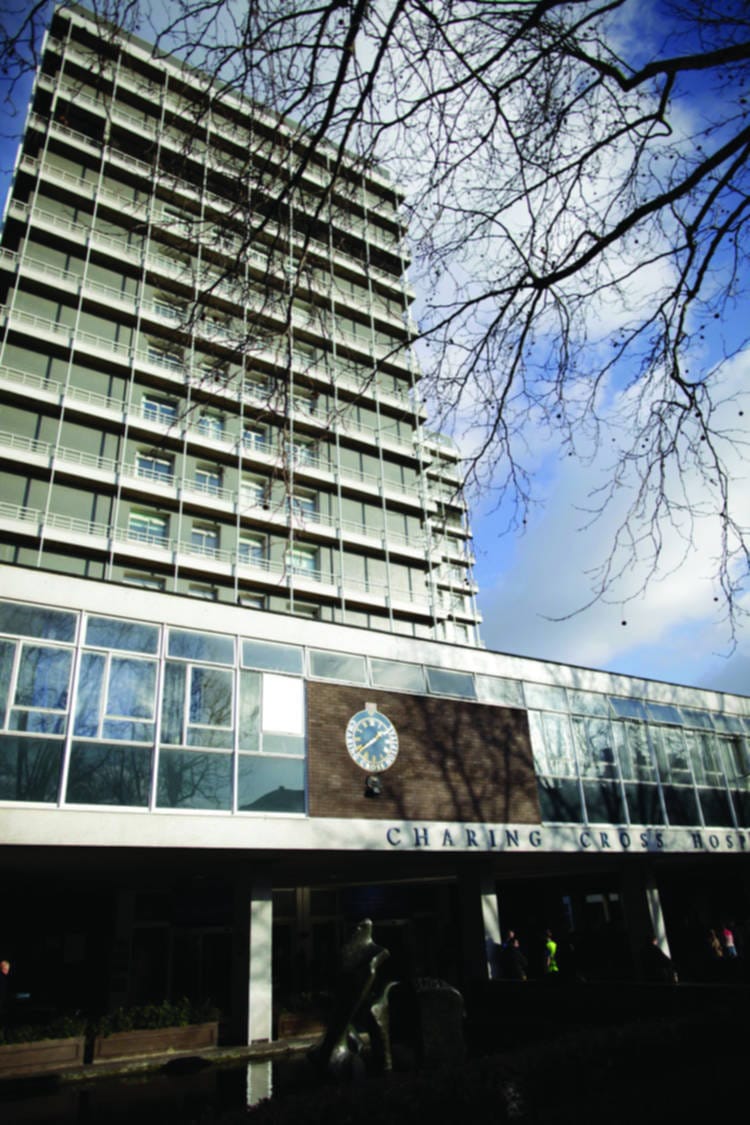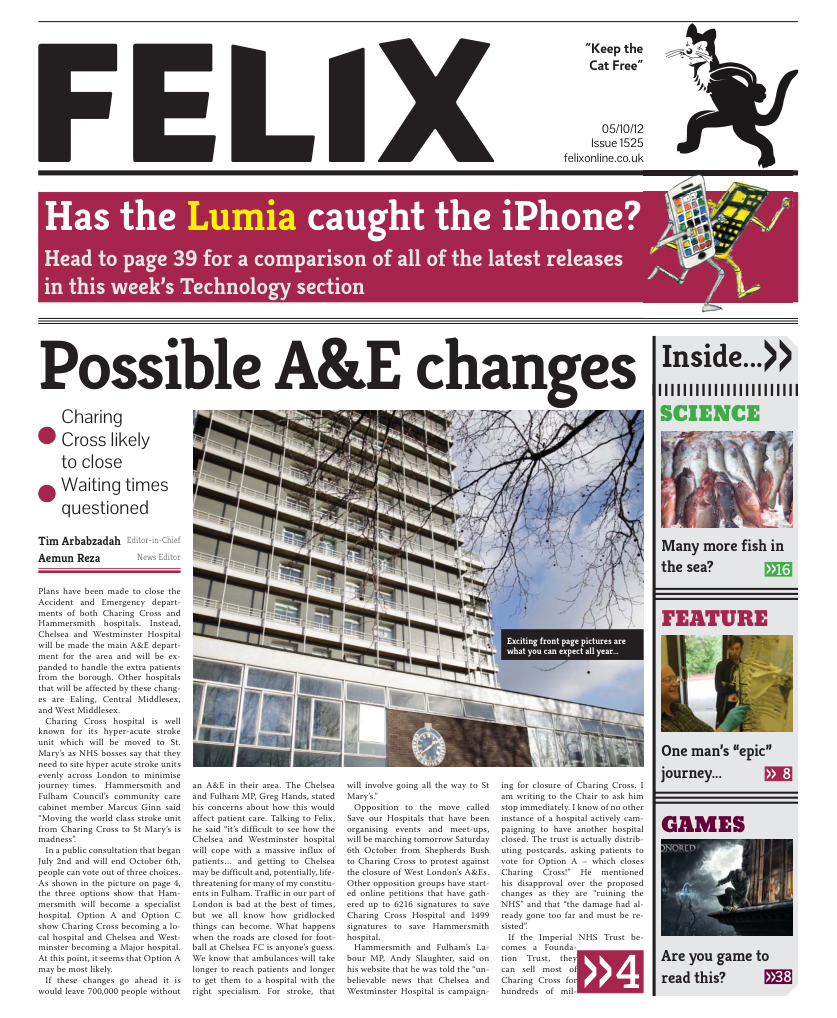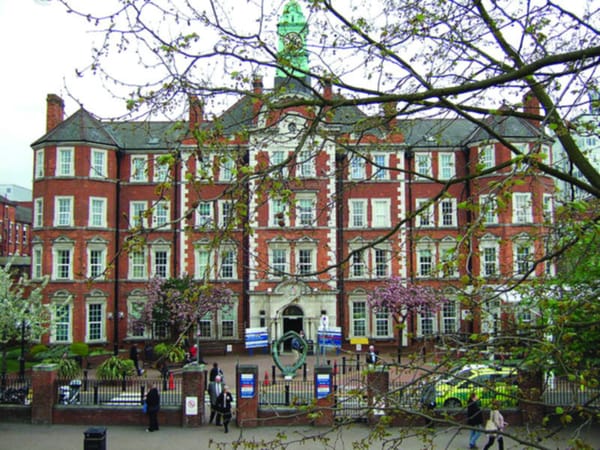Possible A&E changes
Charing Cross likely to close. Waiting times questioned

Plans have been made to close the Accident and Emergency departments of both Charing Cross and Hammersmith hospitals. Instead, Chelsea and Westminster Hospital will be made the main A&E department for the area and will be expanded to handle the extra patients from the borough. Other hospitals that will be affected by these changes are Ealing, Central Middlesex, and West Middlesex. Charing Cross hospital is well known for its hyper-acute stroke unit which will be moved to St. Mary’s as NHS bosses say that they need to site hyper acute stroke units evenly across London to minimise journey times. Hammersmith and Fulham Council’s community care cabinet member Marcus Ginn said “Moving the world class stroke unit from Charing Cross to St Mary’s is madness”.
In a public consultation that began July 2nd and will end October 6th, people can vote out of three choices. As shown in the picture on page 4, the three options show that Hammersmith will become a specialist hospital. Option A and Option C show Charing Cross becoming a local hospital and Chelsea and Westminster becoming a Major hospital. At this point, it seems that Option A may be most likely.
If these changes go ahead it is would leave 700,000 people without an A&E in their area. The Chelsea and Fulham MP, Greg Hands, stated his concerns about how this would affect patient care. Talking to Felix, he said “it’s difficult to see how the Chelsea and Westminster hospital will cope with a massive influx of patients… and getting to Chelsea may be difficult and, potentially, life-threatening for many of my constituents in Fulham. Traffic in our part of London is bad at the best of times, but we all know how gridlocked things can become. What happens when the roads are closed for football at Chelsea FC is anyone’s guess. We know that ambulances will take longer to reach patients and longer to get them to a hospital with the right specialism. For stroke, that will involve going all the way to St Mary’s.”
Opposition to the move called Save our Hospitals that have been organising events and meet-ups, will be marching tomorrow Saturday 6th October from Shepherds Bush to Charing Cross to protest against the closure of West London’s A&Es. Other opposition groups have started online petitions that have gathered up to 6216 signatures to save Charing Cross Hospital and 1499 signatures to save Hammersmith hospital.
Hammersmith and Fulham’s Labour MP, Andy Slaughter, said on his website that he was told the “unbelievable news that Chelsea and Westminster Hospital is campaigning for closure of Charing Cross. I am writing to the Chair to ask him stop immediately. I know of no other instance of a hospital actively campaigning to have another hospital closed. The trust is actually distributing postcards, asking patients to vote for Option A – which closes Charing Cross!” He mentioned his disapproval over the proposed changes as they are “ruining the NHS” and that “the damage had already gone too far and must be resisted”.
If the Imperial NHS Trust becomes a Foundation Trust, they can sell most of Charing Cross for hundreds of millions. The land value for Charing Cross Hospital is exceedingly large as anyone who buys the land will be able to build up to the same height as the building that they knock down, which would be fourteen stories for Charing Cross Hospital.
A foundation trust can keep the receipt when it sells land and use the money for its own purposes, whereas Imperial’s current status means it would be forced to hand any capital receipt to the Department of Health.
The Imperial NHS trust has already been under fire over its record handling and this questions the competence of the trust as a whole and its ability to manage such dramatic changes to patient care. Greg Hands said that ‘the whole process is in danger of being driven by land values and the Trust’s ambitions instead of the best care for patients across West London’.
Greg Hands continued on to say that “making sure there is 24/7 cover from consultants is obviously good; leaving an entire London borough without an A&E is not. At the moment, this seems to be about Imperial NHS Trust’s needs, not patients’ needs. I am fighting hard to change that”. Medical students of Imperial College London use both hospitals for teaching, and concerns have been made as to how this will affect Imperial medics. If the plans go through Charing Cross will no longer be a teaching hospital, which will have a big impact on the way medicine is taught at Imperial. ICSM President, Shiv Vohra, commented saying: “At the moment students are in the dark as to what the proposals will mean for their future education, and would like to be kept in the loop about the planned changes and how it will affect them. Particularly in relation to the Charing Cross hospital, which is the hub of the medical school.”
Felix asked a spokeswoman from Imperial College Healthcare NHS Trust, about whether the changes would have a positive or negative effect on education. In her response she mentioned that, “the three options will affect the Trust in differing ways and as a consultee the Trust is considering what the proposals mean for our services, staff and sites. We have agreed with Imperial College London that we will formulate a joint response as an Academic Health Science Centre (AHSC) as it is crucial that the feedback includes how these proposals will affect the AHSC’s tripartite mission of vastly improving healthcare through service, education and research.”
With the public consultation ending on 6th October and the proposed changes taking up to three years to be implemented, it could be a while before the exact effects to medical students and patients is known.









